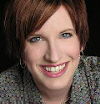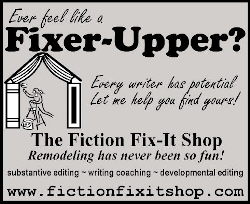
Meredith Efken is the owner of the Fiction Fix-It Shop, exclusively serving writers of adult and YA fiction. A multi-published novelist as well as freelance editor and writing coach, she is passionate about great stories and about empowering other writers to reach their full potential. Actively pursuing that desire, she started Fiction Fix-It Shop in 2006 where she has helped many fiction writers achieve their personal and professional goals. Her clients include award-winning Christian fiction authors such as Deborah Raney and Randall Ingermanson. She is also a member of the American Christian Fiction Writers as well as Word Sowers Christian Writers – a local group she has cofounded. Meredith currently lives in Omaha, Nebraska with her husband, Jason and 2 lively daughters. |
Don’t Be Afraid of the Dark! |
There’s just some places we should not take our readers and we should not go...What does dark represent? Evil? Hopelessness? Death, sorrow? Loss, defeat, ignorance, loneliness? How about anxiety? Or: Pain. Destruction. Emptiness. (What? Am I feeling okay? Yeah, I’m in a great mood! Why?) It’s no wonder most of us find the dark a bit frightening. In most cultures, including our own, the dark symbolizes everything that is dangerous and evil and terrifying. The dark is a powerful picture of our deepest fears and secrets—a place where evil can hide and rule. A place devoid of hope or triumph. Dark is the absence of light. The absence of color. We humans have a psychological response to light. People who live in rainy, cloudy areas have a higher rate of depression because of the lack of sunlight. We get vitamin D from sunlight. Light is used to cure jaundice in newborns, improve our moods, and help our immune systems. It’s no wonder we love the light. But the dark has its benefits, too. Many researchers say we need total darkness when we sleep—it promotes healing, proper hormone function, and a reduction in anxiety and stress. Darkness can be peaceful, calming, and a necessary contrast to the busy colors of the light. In fiction, we need this contrast between light and dark, too. It’s easy to fill a book with good times for our characters. Most authors feel very affectionate toward their characters—as if they were real people. We don’t want to harm our characters or make them suffer too much. We don’t want them to face too much darkness. We’re afraid of overwhelming our readers, too. I’ve heard many Christian writers say, “But as Christians, we’re not supposed to despair. We’re not to glorify evil. There’s just some places we should not take our readers and we should not go.” Nonsense! If our novels consist of only “more light” and “less light” with little or no real darkness, how much impact will that light have? There’s no contrast. No reason to appreciate the light because there’s no dark to compare it with. Readers want stories with struggles, with conflict. They want to see their heroes experience the full range of human emotions—from ecstasy to despair. “Happy-happy-joy-joy” gets boring after a while. Why is that? Why do we love to read about characters suffering in ways we hope and pray we never experience? Several reasons:
• It’s cathartic. The drama and the trials, the pain or suffering in
the story gives us an emotional outlet, a way to release our own
emotions in a safe, controlled way. It’s a healthy way to cleanse our
own souls. |
Paul McCusker, a well-known novelist and playwright, once said that “There would be no Easter Sunday without Good Friday.” He’s right—unless there was the darkness and defeat of the crucifixion, there would be no triumph and victory of the resurrection. That’s about as big a contrast between light and dark as you can get. Far from glorifying evil, the story of crucifixion and resurrection is a story of the triumph of everything that is good, holy, and perfect. But we needed the darkness to get to that point. This doesn’t mean that every single book needs the depths and despair of tragedy or horrific evil. Different genres call for different proportions of dark and light. But every story should have a clear moment where the dark (in whatever intensity you choose) seems like it will prevail. There should always be that moment where the hero appears to have lost. The Dark Moment. Donald Maass, a popular literary agent and writing teacher, calls it “sending your character over the cliff into the abyss.” Too many times, he says, we pull our character back from the brink. We save our heroes too early. He advocates letting them make the plunge. Don’t rescue them too soon. How can we make things worse for our characters? One powerful way is to combine external threats and challenges with strong inner conflict and turmoil. Layered like this, these conflicts raise the tension and stakes of the story and make failure an even more unthinkable outcome. What are you, the author, most afraid of doing to your character? Do it! (Well, maybe short of killing them—but don’t take even that off the table too quickly!) In 2007, when the final Harry Potter novel came out, the author, J.K. Rowling, was interviewed about the process she went through to write Harry Potter and the Deathly Hallows. Chapter 34 is the Dark Moment of the entire seven-book series. In case you’re one of the few people left on the planet who haven’t read it, I won’t spoil it for you. But it involves Harry, and it was a scene Rowling had envisioned from the beginning. It’s an incredibly emotional, poignant scene. In the interview, Rowling admitted that when she finally wrote it, she was an emotional wreck. She didn’t just send her character over the cliff—she went with him. That left a big impression on me. As a writer, do I enter into my character’s life to the point where I not only send her over the cliff, but also take the plunge with her? Chapter 34 of Deathly Hallows is simply written but rich with authentic emotion. It’s one of my favorite literary moments ever. I believe it’s because the author didn’t hold herself back. She let the worst happen to her character and she entered into it fully, even though she knew the eventual outcome. The story has power because of that. Give readers the “Dark Moment” in all its cathartic, emotional mess. Let them fail. Let them suffer. Don’t hold back. Go for pitch-black, 3:00 a.m. dark. Then light a match for them. A candle. And another, and still another. Let the sun rise slowly. Let them triumph after all. We can’t conquer the dark if we’re too afraid to face it. If we’re too afraid to let our characters face it. We need Good Friday. We need Chapter 34. We need the cliff and the abyss. We don’t need to be scared of the dark.  |







